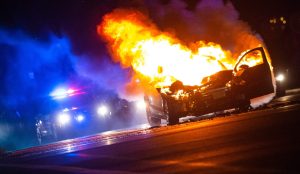
Vehicle fires are complex events that require in-depth analysis to determine their origin and cause. Whether involving automobiles, semi-tractor/trailers, buses, boats, or even airplanes, these incidents can pose significant safety risks and financial consequences. Garrett Forensics’ Fire Investigators specialize in unraveling the causes of vehicle fires through meticulous examination and advanced forensic techniques.
Garrett’s Fire & Arson experts are committed to providing scientifically rigorous investigations into fire and explosion incidents. Our Fire Investigators adhere to the guidelines set forth by the National Fire Protection Association (NFPA), which are widely regarded as the gold standard for conducting precise and well-informed analyses of these events.
Common Causes of Vehicle Fires
Vehicle fires can occur for various reasons, ranging from mechanical failures to deliberate acts of arson. Some of the primary causes include:
- Electrical Malfunctions: Wiring defects, short circuits, and battery failures are common culprits of vehicle fires. Poor maintenance or manufacturing defects can lead to overheating and ignition. Modern vehicles often contain extensive electrical systems, increasing the likelihood of electrical failures if not properly maintained.
- Mechanical Failures: Issues such as leaking fuel lines, overheating engines, or faulty exhaust systems can generate enough heat to ignite surrounding materials. Engine components that rub together over time can create frictional heat, which, combined with combustible fluids, may result in fire outbreaks.
- Collisions and Accidents: High-impact crashes can rupture fuel systems, spark electrical connections, or expose flammable materials, leading to fires. Even minor accidents can damage sensitive wiring or fuel lines, creating hazardous conditions.
- Arson: In some cases, fires are intentionally set for insurance fraud or other criminal activities. Trained fire investigators use evidence-based techniques to determine if a fire was deliberately ignited. Arson investigations require extensive expertise to differentiate between accidental and intentional fires.
- Spontaneous Combustion: In rare cases, vehicles with specific chemical exposure or improper storage of combustible materials can lead to spontaneous combustion.
The Investigation Process
Garrett Forensics’ experts employ a systematic approach when investigating vehicle fires. Their goal is to determine the precise cause, ruling out possibilities through scientific examination. The process typically includes:
- Scene Examination: Investigators assess the burn patterns, fire damage, and environmental factors to establish the fire’s point of origin. They document fire spread patterns and analyze any external conditions that may have contributed to ignition.
- Component Analysis: Critical vehicle components, including fuel lines, electrical systems, and mechanical parts, are inspected for signs of failure. Investigators disassemble parts of the vehicle, looking for evidence of overheating, wiring malfunctions, or fuel leaks.
- Evidence Collection: Samples of debris, wiring, and fuel residue are analyzed for potential accelerants or other indicators of arson. Investigators may use chemical analysis and forensic testing to detect traces of flammable substances.
- Expert Testing: Laboratory simulations and reconstructions help validate hypotheses about the fire’s cause. Fire behavior modeling can be used to recreate fire dynamics and confirm investigative findings.
- Reporting and Litigation Support: Findings are documented in detailed reports, which may be used in insurance claims, legal cases, or safety recommendations. Expert testimony may also be provided in legal proceedings to support findings.
Real-World Applications of Fire Investigations
Vehicle fire investigations play a crucial role in several industries, including:
- Insurance Claims: Insurers rely on forensic fire investigations to assess claims related to vehicle fires, ensuring that fraud is detected and legitimate claims are processed efficiently.
- Product Liability Cases: Manufacturers may be held responsible if a design flaw or defective component led to a vehicle fire. Investigations help identify liability and improve safety standards.
- Legal Proceedings: Fire investigation reports and expert witness testimony are often used in court cases involving fire-related damages, injuries, or fatalities.
Conclusion
Vehicle fires require expert investigation to determine their root cause—whether accidental, mechanical, electrical, or intentional. Without a thorough and scientifically grounded analysis, misattributing the origin or cause of a fire can lead to costly legal disputes, denied insurance claims, or missed opportunities to identify safety concerns.
At Garrett Forensics, our certified Fire Investigators bring decades of experience, rigorous scientific methodology, and a detail-oriented approach to every case. From analyzing burn patterns and electrical systems to reconstructing pre- and post-incident conditions, we leave no element unchecked in our pursuit of the truth.
Our investigations go beyond surface-level observations to uncover the sequence of events that led to the fire, distinguishing between product failure, human error, and criminal activity. By combining forensic engineering with fire science, we deliver clear, evidence-based conclusions that can withstand scrutiny in courtrooms, insurance proceedings, and regulatory reviews.
Whether you’re a claims professional assessing liability, an attorney preparing litigation, or a manufacturer seeking to understand potential design vulnerabilities, Garrett Forensics equips you with the facts needed to make confident, informed decisions. When the cause of a vehicle fire matters, trust the experts who can reveal it with clarity and integrity.
Recent Posts
- Product Failure Analysis: When Consumer Devices Become Courtroom Evidence
- Forensic Electrical & Fire Investigation Collaboration: When Multidisciplinary Expertise Saves the Case
- Biomechanical Injury Analysis: How Science Proves or Disputes Injury Claims
- How Structural Engineers Help Uncover the Cause of Building Failures
- Forensic Investigations in Micromobility Accidents: E-Scooters, E-Bikes, and More

Leave a Reply